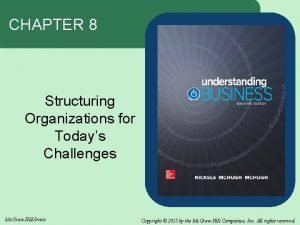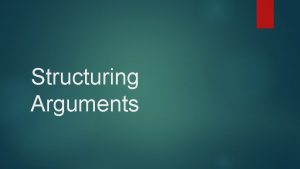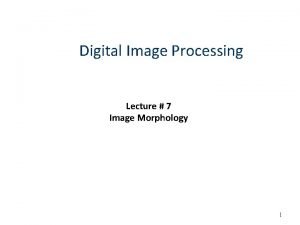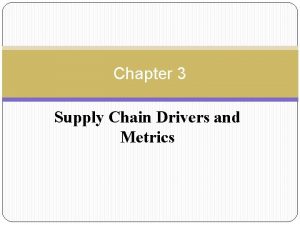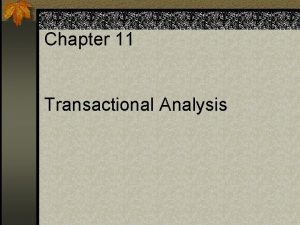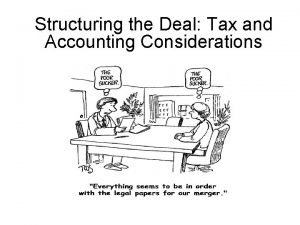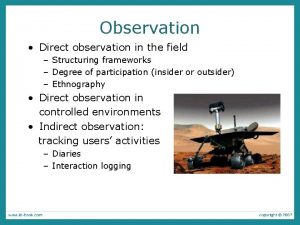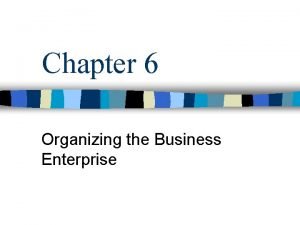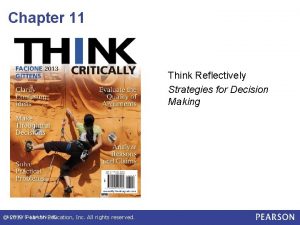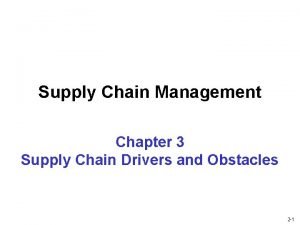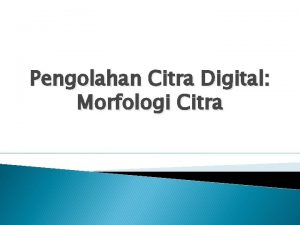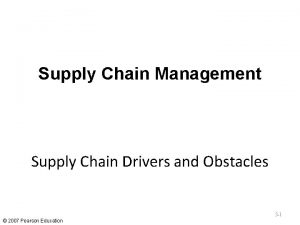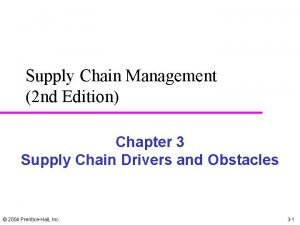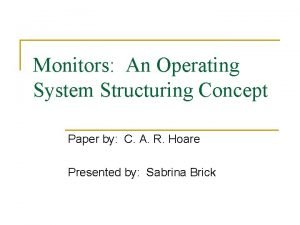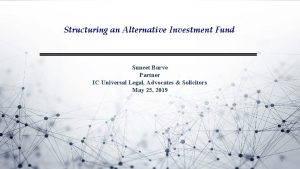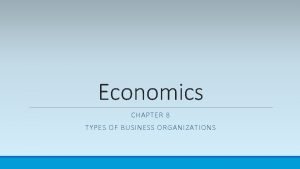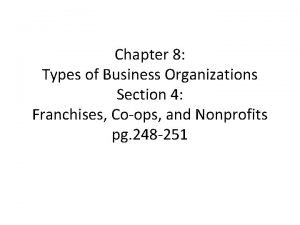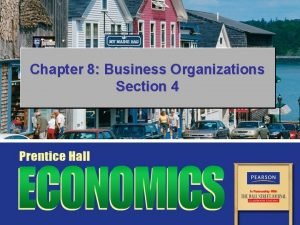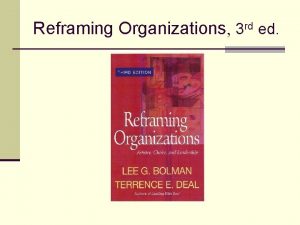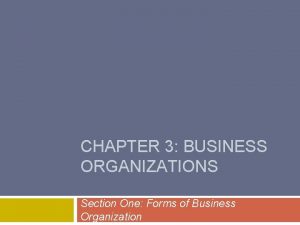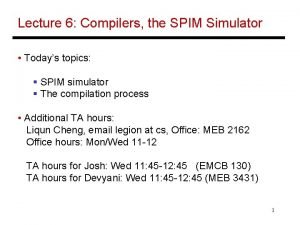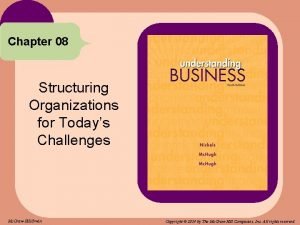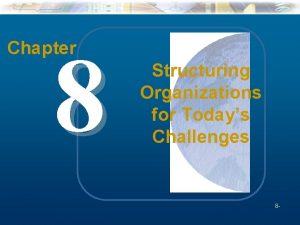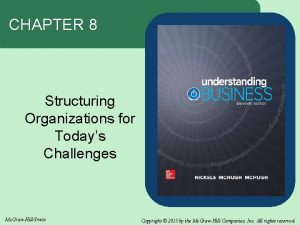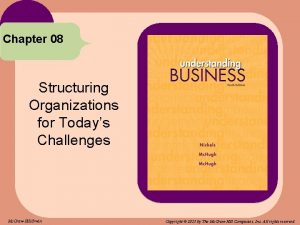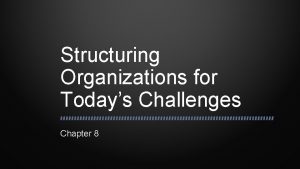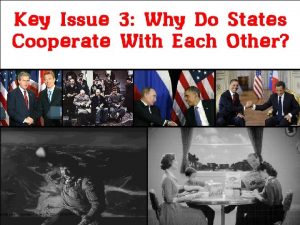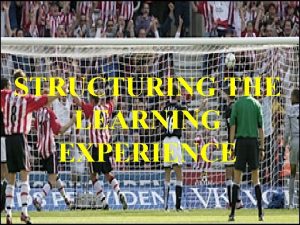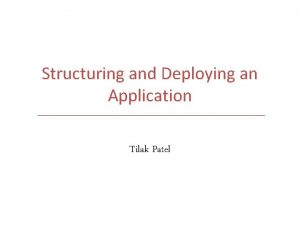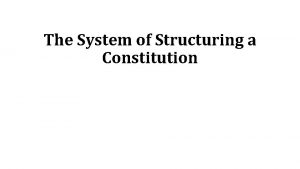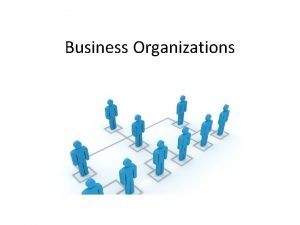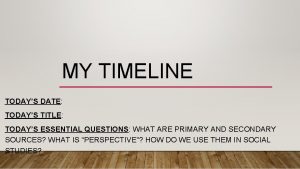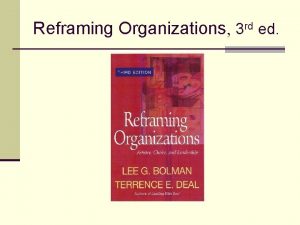CHAPTER 8 Structuring Organizations for Todays Challenges Mc









































- Slides: 41

CHAPTER 8 Structuring Organizations for Today’s Challenges Mc. Graw-Hill/Irwin Copyright © 2015 by the Mc. Graw-Hill Companies, Inc. All rights reserved.

STRUCTURING an ORGANIZATION LO 8 -1 • Create a division of labor • Set up teams or departments • Allocate resources • Assign tasks • Establish procedures • Adjust to new realities 8 -2

HOW MUCH CHANGES in a DECADE? LO 8 -2 What? 2000 2010 Amount of cell phone use 34% 89% Number of active blogs 12, 000 141, 000 Amount of reality shows 4 320 Daily emails sent 12 billion 247 billion Number of hours spent online per week 2. 7 18 Number of daily newspapers 1, 480 1, 302 Number of daily letters mailed 207 billion 175 billion Amount of books published 282, 242 1, 052, 803 i. Tunes downloads 0 10 billion Percentage of obese Americans 26% 34% Source: Fast Company, www. fastcompany. com, accessed March 2014. 8 -3

CREATING ORGANIZATIONAL STRUCTURE • Hierarchy -- A system in which one person is at the top of an organization and there is a ranked or sequential ordering from the top down. • Chain of Command -- The line of authority that moves from the top of the hierarchy to the lowest level. • Organization Chart -- A visual device that shows relationships among people and divides the organization’s work; it shows who reports to whom. LO 8 -2 8 -4

TYPICAL ORGANIZATION CHART LO 8 -2 8 -5

BUREAUCRATIC ORGANIZATIONS LO 8 -2 • Bureaucracy -- An organization with many layers of managers who set rules and regulations and oversee all decisions. • It can take weeks or months to have information passed down to lower-level employees. • Bureaucracies can annoy customers. 8 -6

KEY ORGANIZATIONAL CONSIDERATIONS § LO 8 -2 Job design § Divide work into parts or tasks and assign positions to those parts § Departmentalization § Group the positions into manageable units or departments § Delegation § Assign part of a manager’s work and power to other workers § Span of management § The number of workers who report directly to one manager (wide vs. narrow) § Degree of Centralization § The extent to which decision-making power is held by a small number of people at the top of the organization (tall vs. flat) § Chain of command § Designate the positions with direct authority and those that are support positions (i. e. create LINE and STAFF hierachy) 7 -7

JOB DESIGN: ASSIGNING POSITIONS TO TASKS OR DUTIES LO 8 -2 BROAD JOB RESPOSIBILITY VS. JOB SPECIALIZATION Many jobs or tasks (BROAD) or single or few jobs (SPECIALIZATION)? Which is better? Does it matter? Cost and work considerations? 7 -8

DEPARTMENTALIZATION LO 8 -3 • Departmentalization -- Divides organizations into separate units (i. e. grouping positions into manageable units or departments). • Workers are grouped by skills and expertise to specialize their skills. 8 -9

WAYS to DEPARTMENTALIZE LO 8 -3 8 -10

WAYS to DEPARTMENTALIZE LO 8 -3 8 -11

DELEGATION Delegation—assigning part of a manager’s work and power to other workers • Steps in delegation • Responsibility—the duty to do a job or perform a task • Authority—the power, within an organization, to accomplish an assigned task • Accountability—the obligation to accomplish an assigned job or task • Barriers to delegation –Fear the work will not get done –Fear the work will be done too well –Inability to plan and assign work effectively §The manager assigns responsibility. §The subordinate is empowered to do the task. §Ultimate accountability remains with the manager. 8 -12

SPAN of MANAGEMENT (CONTROL) LO 8 -3 • Span of Management (Control) -- The optimal number of subordinates a manager supervises or should supervise. • When work is standardized, broad spans of control are possible. • Appropriate span narrows at higher levels of the organization. • The trend today is to reduce middle managers and hire better low-level employees. 8 -13

ORGANIZATIONAL STRUCTURES LO 8 -3 • Structures determine the way the company responds to employee and customer needs. • Tall Organization Structures -- An organizational structure in which the organization chart would be tall because of the various levels of management. • Flat Organization Structures -- An organizational structure that has few layers of management and a broad span of control. • Wide Organization Structure – An organizational structure where a manager manages many subordinates • Narrow Organizational Structure – An organizational structure where a manager manages only one or few subordinates • Trend today – FLAT and WIDE 8 -14

FLAT ORGANIZATIONAL STRUCTURE LO 8 -3 8 -15

ADVANTAGES and DISADVANTAGES of the DIFFERENT SPANS of CONTROL LO 8 -3 8 -16

CENTRALIZATION or DECENTRALIZATION? LO 8 -3 • Centralized Authority -- When decision-making is concentrated at the top level of management. • Decentralized Authority -When decision-making is delegated to lower-level managers and employees more familiar with local conditions than headquarters is. 8 -17

CENTRALIZATION and DECENTRALIZATION LO 8 -3 8 -18

FOUR WAYS to STRUCTURE an ORGANIZATION LO 8 -4 1. Line Organizations 2. Line-and-Staff Organizations 3. Matrix-Style Organizations 4. Cross-Functional Self. Managed Teams 8 -19

LINE ORGANIZATIONS LO 8 -4 • Line Organization -- Has direct two-way lines of responsibility, authority and communication running from the top to the bottom. Everyone reports to one supervisor. • There are no specialists, legal, accounting, human resources or information technology departments. • Line managers issue orders, enforce discipline and adjust the organization to changes. 8 -20

LINE PERSONNEL LO 8 -4 • Line Personnel -- Workers responsible for directly achieving organizational goals, and include production, distribution and marketing employees. • Line personnel have authority to make policy decisions. 8 -21

STAFF PERSONNEL LO 8 -4 • Staff Personnel -- Employees who advise and assist line personnel in meeting their goals, and include marketing research, legal advising, IT and human resource employees. 8 -22

SAMPLE LINE-and-STAFF ORGANIZATION LO 8 -4 8 -23

MATRIX ORGANIZATIONS LO 8 -4 • Matrix Organization -- Specialists from different parts of the organization work together temporarily on specific projects, but still remain part of a line-and-staff structure. • Emphasis is on product development, creativity, special projects, communication and teamwork. 8 -24

SAMPLE MATRIX ORGANIZATION LO 8 -4 8 -25

CROSS-FUNCTIONAL SELF-MANAGED TEAMS LO 8 -4 • Cross-Functional Self-Managed Teams -- Groups of employees from different departments who work together on a long-term basis. • A way to fix the problem of matrix-style teams is to establish long-term teams. • Empower teams to work closely with suppliers, customers and others to figure out how to create better products. 8 -26

GOING BEYOND ORGANIZATIONAL BOUNDARIES LO 8 -4 • Cross-functional teams work best when the voice of the customer is heard. • Teams that include customers, suppliers and distributors go beyond organizational boundaries. • Government coordinators may assist in sharing market information beyond national boundaries. 8 -27

BUILDING SUCCESSFUL TEAMS LO 8 -4 Important Conditions for Small Teams • Clear purpose • Clear goals • Correct skills • Mutual accountability • Shift roles when appropriate Source: CIO Magazine, www. cio. com, accessed November 2014. 8 -28

REAL-TIME BUSINESS LO 8 -5 • Networking -- Using communications technology to link organizations and allow them to work together. • Most companies are no longer self-sufficient; they’re part of a global business network. • Real Time -- The present moment or actual time in which something takes place. 8 -29

TRANSPARENCY and VIRTUAL CORPORATIONS LO 8 -5 • Transparency -- When a company is so open to other companies that electronic information is shared as if the companies were one. • Virtual Corporation -- A temporary networked organization made up of replaceable firms that join and leave as needed. 8 -30

A VIRTUAL CORPORATION LO 8 -5 8 -31

CUTTING BACK WHILE CUTTING COSTS • Hiring workers is a major expense for small business owners. • This has led to more offshore outsourcing. • The increase can be partly attributed to the presence of online job marketplaces like ODesk. 8 -32

BENCHMARKING and CORE COMPETENCIES LO 8 -5 • Benchmarking -- Compares an organization’s practices, processes and products against the world’s best. • Core Competencies -- The functions an organization can do as well as or better than any other organization in the world. • K 2 Skis researched other companies’ practices in order to create the best possible skis and snowboards. 8 -33

BENEFITS and CONCERNS of HEALTHCARE OUTSOURCING Benefits • Provides enough staff to operate the facility • Cost savings Source: Healthcare Financial Management. LO 8 -5 Concerns • Lower employee morale • Liability • Should patients be informed • Confidentiality and security 8 -34

WHICH JOBS are most often OUTSOURCED? Source: USA Today. LO 8 -5 8 -35

ADAPTING to MARKET CHANGES LO 8 -5 • Change isn’t easy. Employees like to do things the way they always have. • Get rid of old, inefficient facilities and equipment. • Use the Internet to get to know your customers and sell directly to them. 8 -36

ORGANIZATIONAL CULTURE LO 8 -6 • Organizational or Corporate Culture -- The widely shared values within an organization that foster unity and cooperation to achieve common goals. • Some of the best organizational cultures emphasize service. • Culture is shown in stories, traditions and myths. 8 -37

FORMAL ORGANIZATION LO 8 -6 • Formal Organization -- Details lines of responsibility, authority and position. • The formal system is often slow and bureaucratic, but it helps guide the lines of authority. • No organization can be effective without formal and informal organization. 8 -38

INFORMAL ORGANIZATION LO 8 -6 • Informal Organization -- The system of relationships that develop spontaneously as employees meet and form relationships. • Informal organization helps foster camaraderie and teamwork among employees. 8 -39

LIMITATIONS of INFORMAL ORGANIZATIONS LO 8 -6 • The informal system is too unstructured and emotional on its own. • Informal organization may also be powerful in resisting management directives. 8 -40

GROUP NORMS LO 8 -6 Examples of Informal Group Norms • Do your job but don’t produce more than the rest of your group. • Don’t tell off-color jokes or use profanity. • Everyone is to be clean and organized at the workstation. • Respect and help your fellow group members. • Drinking is done off the job – NEVER at work. Source: CIO Magazine, www. cio. com, accessed November 2014. 8 -41
 Structuring organizations for today's challenges
Structuring organizations for today's challenges Chapter 13 marketing in todays world
Chapter 13 marketing in todays world Structuring system requirements
Structuring system requirements Structuring arguments
Structuring arguments Structuring element
Structuring element Thinning and thickening in image processing example
Thinning and thickening in image processing example Time structuring in transactional analysis
Time structuring in transactional analysis Framework for structuring drivers
Framework for structuring drivers Group leaders of reality therapy groups are
Group leaders of reality therapy groups are Child ego state
Child ego state Deal structuring process
Deal structuring process Direct observation
Direct observation Tax-efficient structuring
Tax-efficient structuring Organizational structuring
Organizational structuring Wide vs narrow span of control
Wide vs narrow span of control Dominance structuring examples
Dominance structuring examples Components of facilities decisions
Components of facilities decisions Islamic structuring
Islamic structuring What are the 5 stages of the counseling process
What are the 5 stages of the counseling process Structuring element dapat berukuran
Structuring element dapat berukuran Structuring element dapat berukuran
Structuring element dapat berukuran Morfologi citra
Morfologi citra Structuring
Structuring Drivers of supply chain management
Drivers of supply chain management Framework for structuring drivers
Framework for structuring drivers Monitors in os
Monitors in os Alternative investment structuring
Alternative investment structuring Smart structuring
Smart structuring Political risk structuring solutions
Political risk structuring solutions Chapter 8 business organizations
Chapter 8 business organizations Chapter 8 section 4 other organizations
Chapter 8 section 4 other organizations Chapter 8 section 4 other organizations
Chapter 8 section 4 other organizations Chapter 1 introduction to management
Chapter 1 introduction to management Reframing organizations chapter 3 summary
Reframing organizations chapter 3 summary Chapter 3 information systems organizations and strategy
Chapter 3 information systems organizations and strategy Chapter 3 business organizations
Chapter 3 business organizations Todays generations
Todays generations We are going today
We are going today Multiple choice comma quiz
Multiple choice comma quiz Todays worldld
Todays worldld Define radient energy
Define radient energy Todays globl
Todays globl
